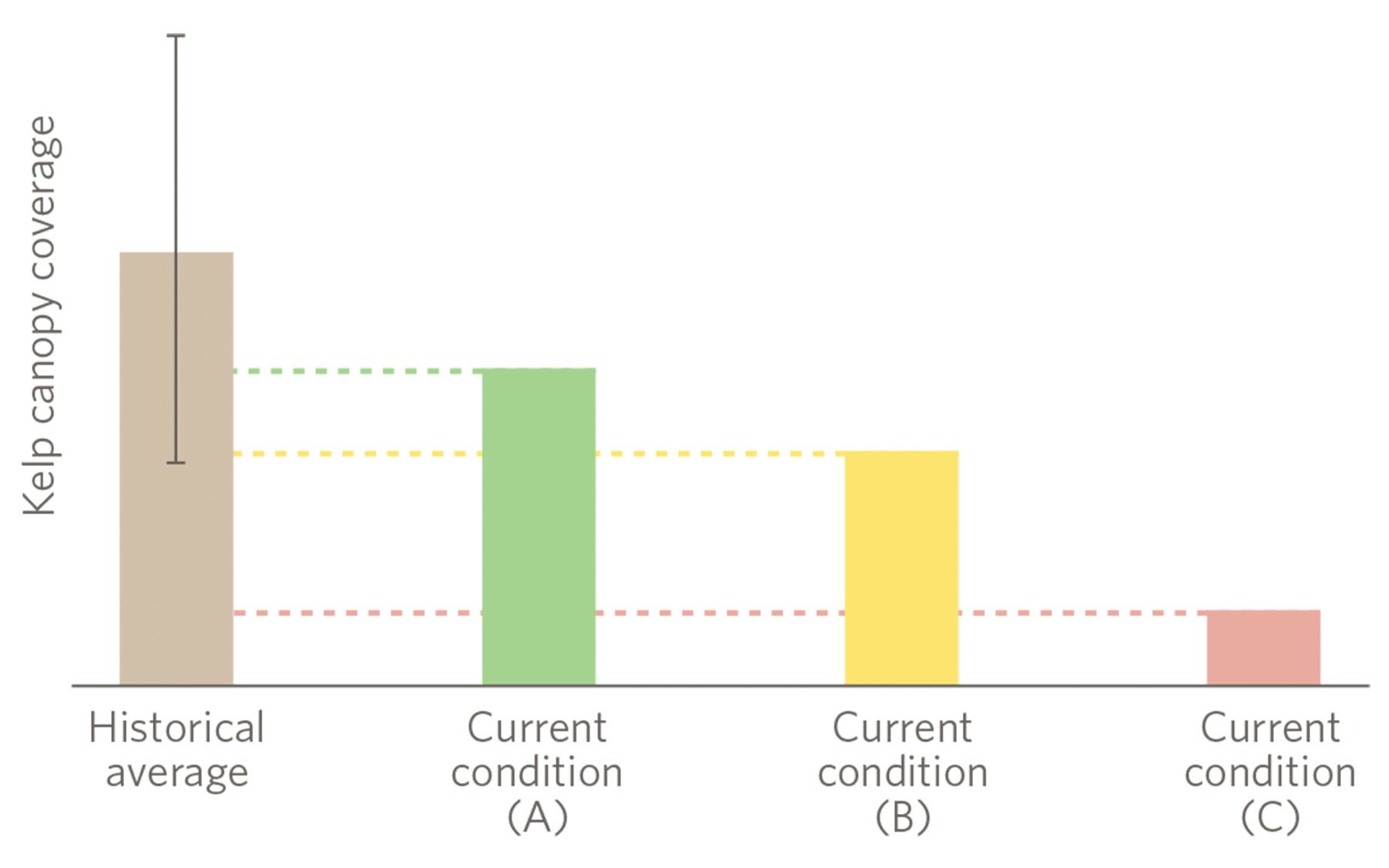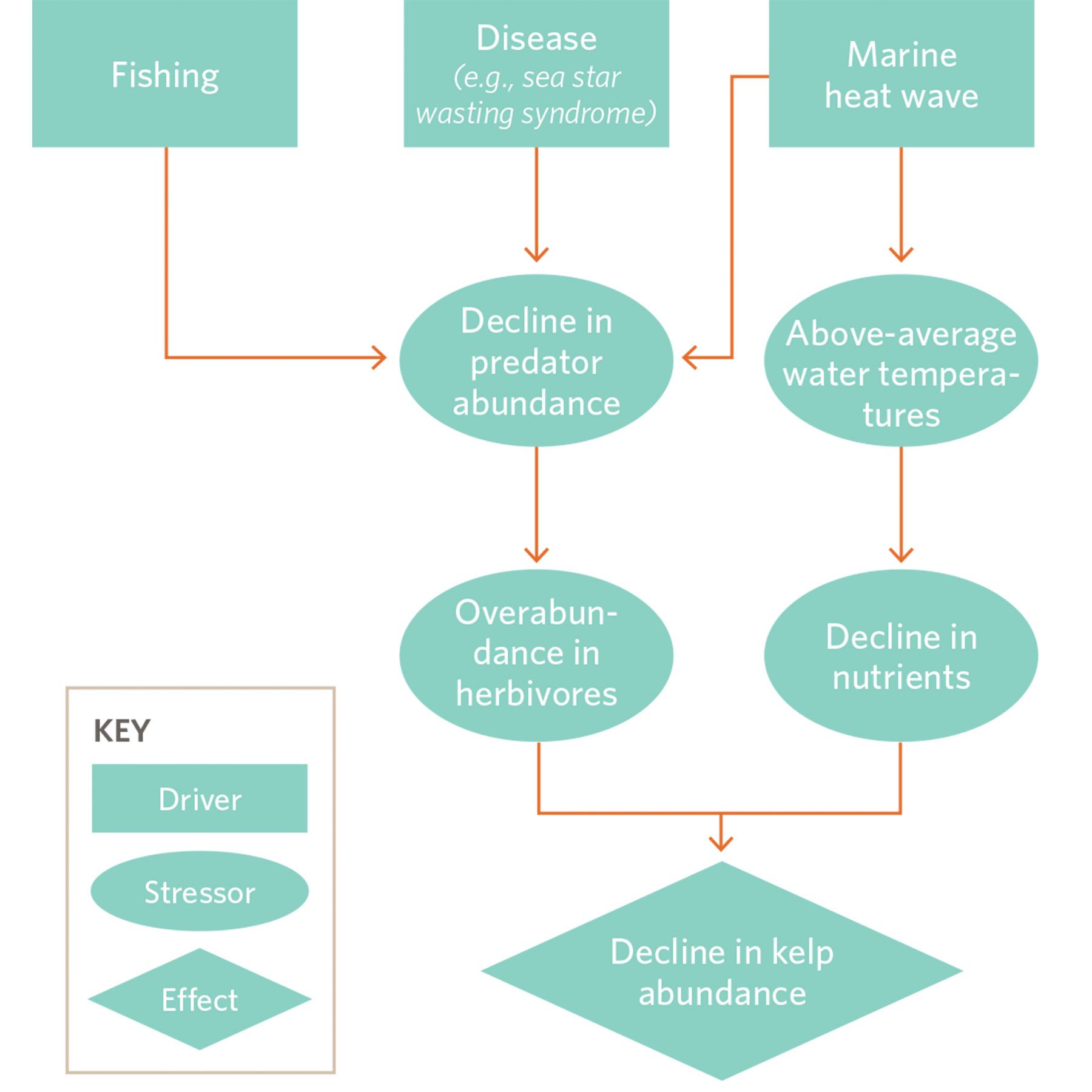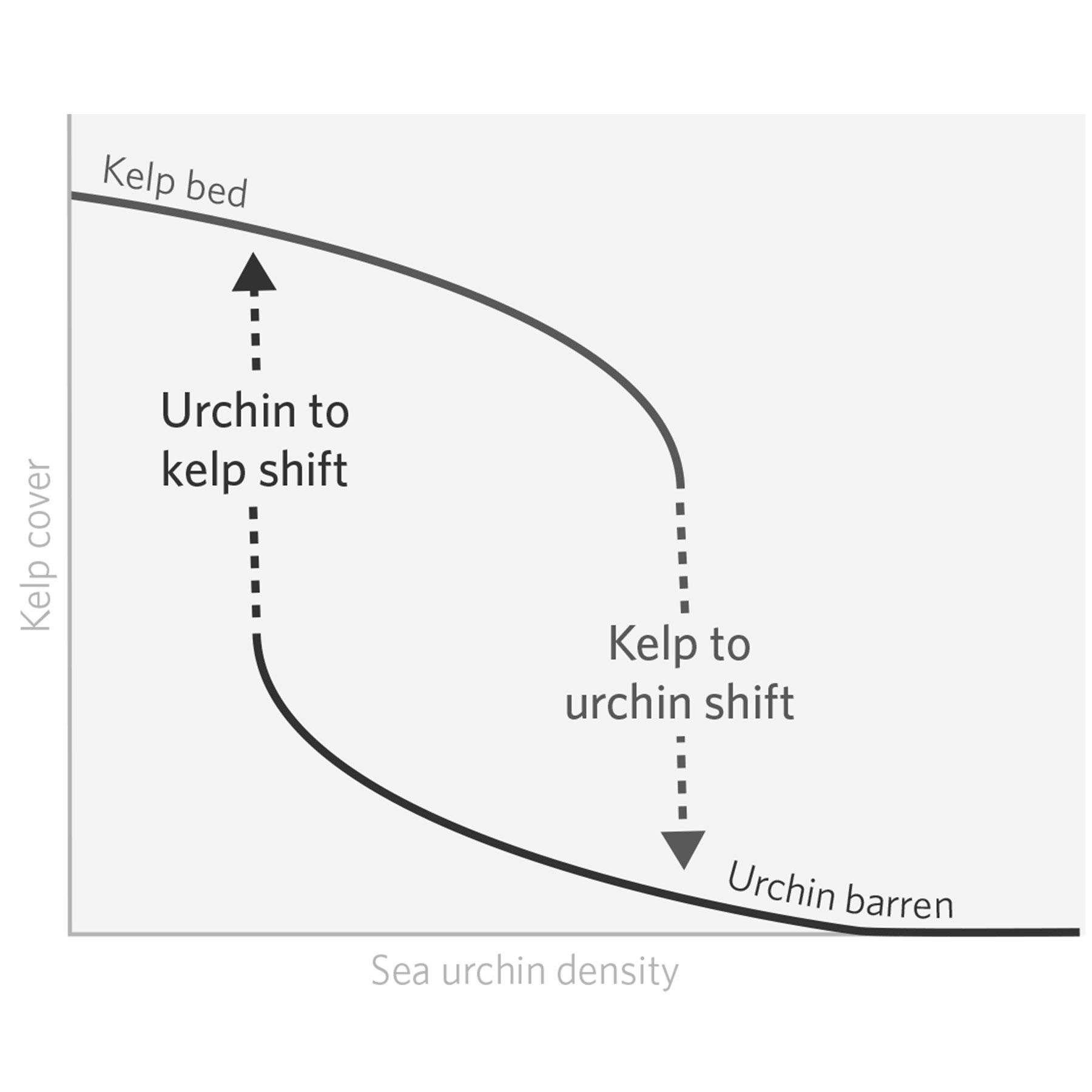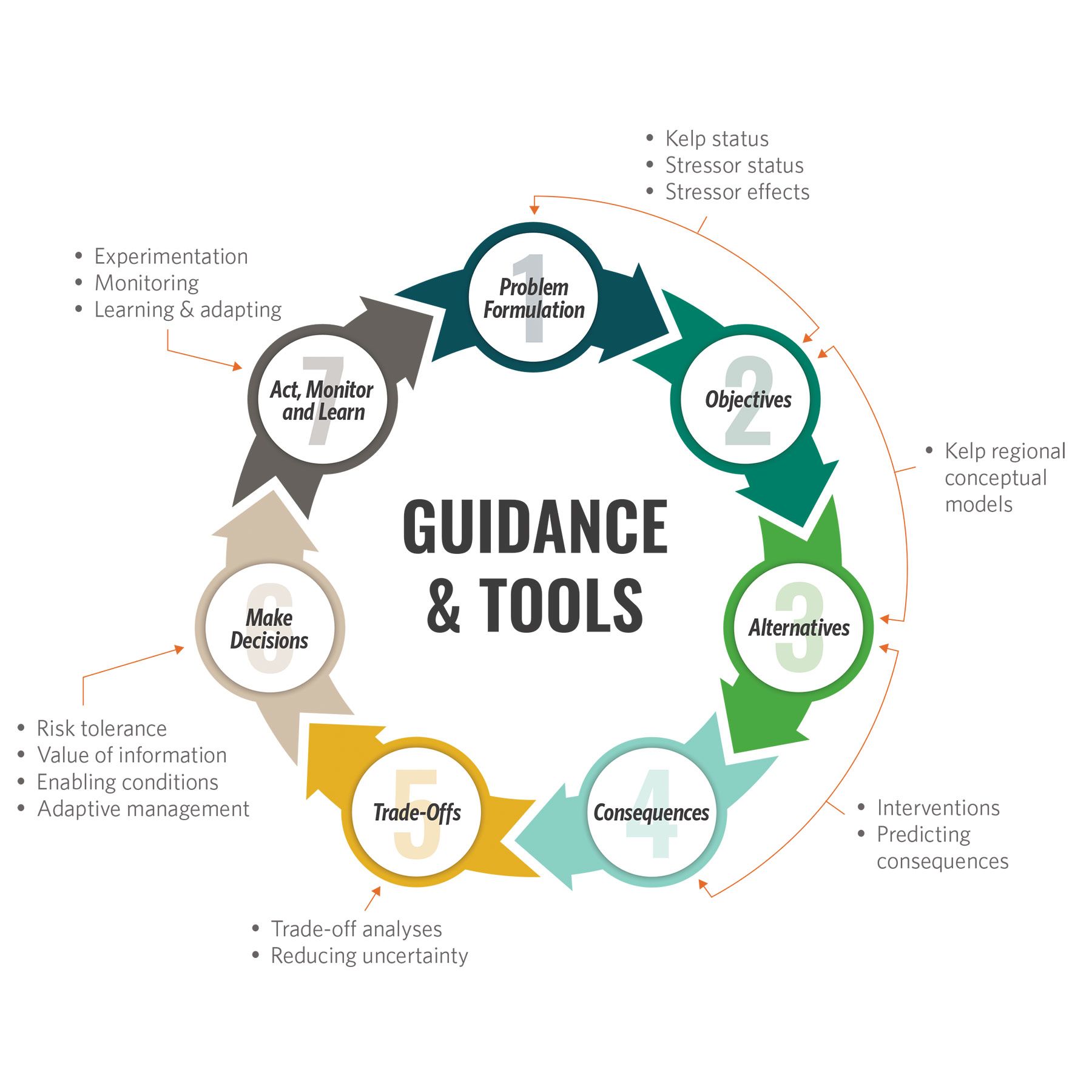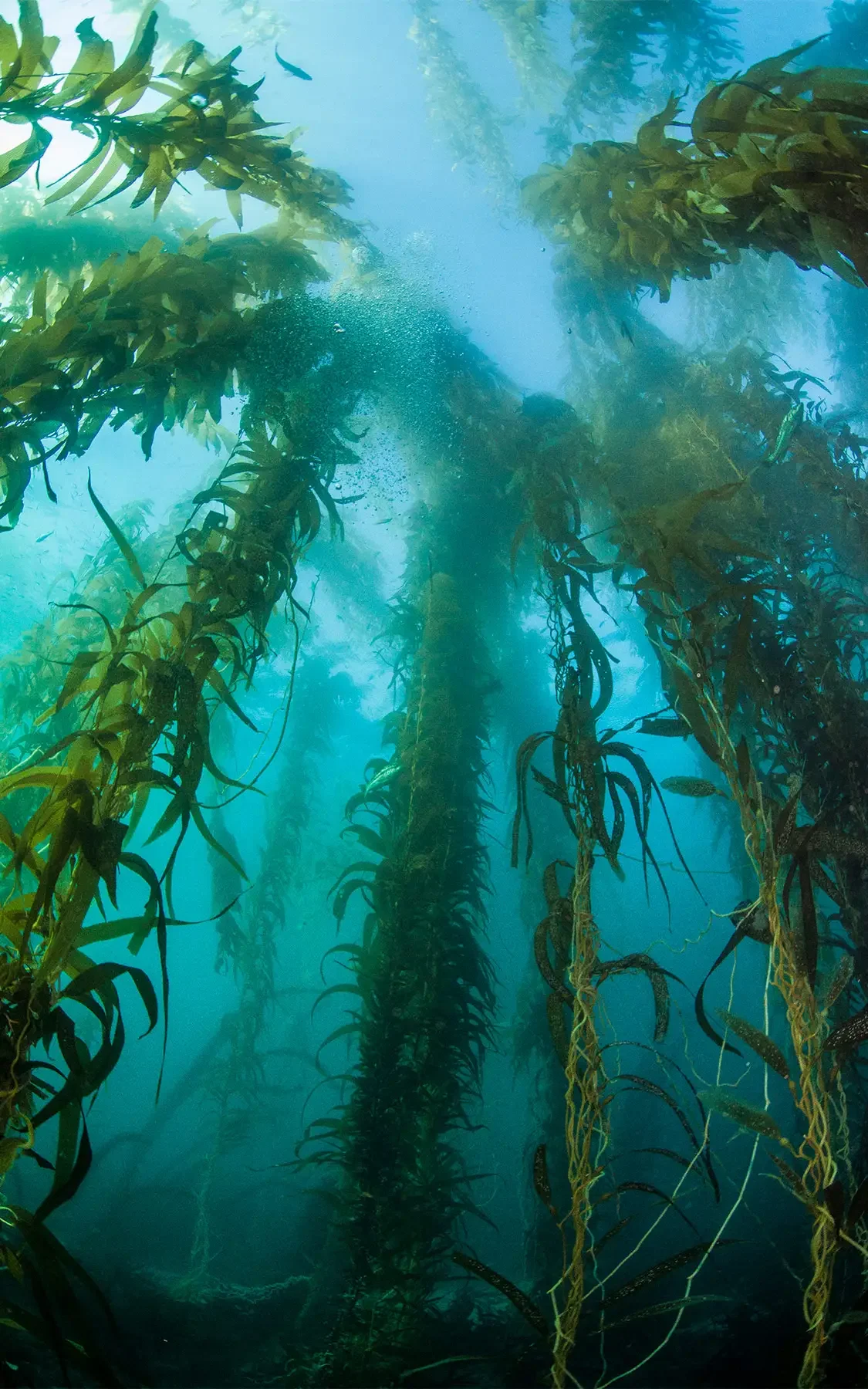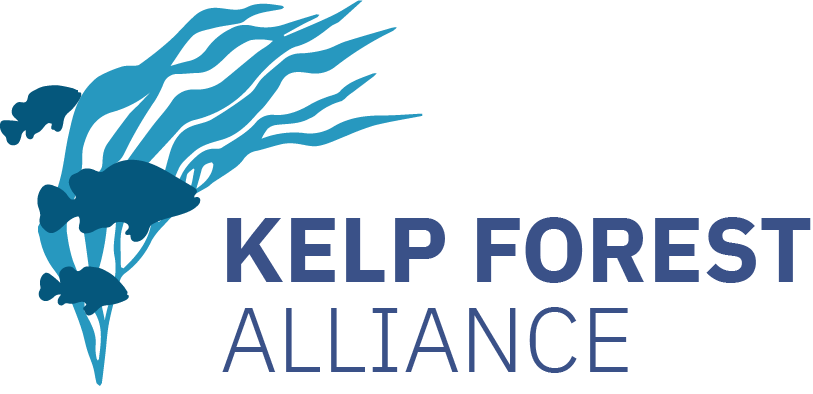Whether to intervene is one of the first and most fundamental decisions when considering how to manage kelp forest loss and restoration. This decision-making process can be refined down to a relative comparison of the risks of action versus inaction. To that end, this process is best informed by several core questions, including the degree of concern about current and predicted kelp losses, the cause(s) of decline, and the resources and restoration approaches that may be available. Altogether, this knowledge provides the foundation of the early planning phases and helps focus resources on defining the problem at hand and the aims of the intervention (chapter 4). Since there is currently limited understanding of potential adverse consequences that may arise from kelp forest restoration actions, a precautionary approach to restoration should be adopted, especially where there may be risks to existing kelp forests or the services they provide (e.g., fisheries).
The knowledge and data necessary to inform restoration and answer the questions described below can sometimes be relatively sophisticated, hard-to-find, or even unknown. Ecological experiments and small-scale trials can help test assumptions and solidify any knowledge-gaps (Sydney: Operation Crayweed). It is also advisable that restorationists plan collaboratively with a variety of stakeholder partners, some of whom may be able assist with collecting, accessing, and interpreting technical data. Such organizations might include local environmental managers and regulators or universities and other research organizations. The success of restoration programs typically requires multi-disciplinary cross-sectoral involvement regardless (chapter 3), so forming collaborative partnerships at these early stages can be an excellent start to a project.
Figure 2.1 Evaluating kelp declines against natural population cycles. Hypothetical graphical depiction of current kelp canopy coverage (in three different scenarios A, B and C) compared to a historical average kelp coverage to guide potential response actions. In this example, standard deviation of historical average is used to reflect the natural range of variability in historical kelp coverage to assess level of concern about current condition; Scenario A is within natural range of variability, Scenario B is just falling below, and Scenario C is well below historical average.
2.1 Five key questions when considering restoration
2.1.1 What are the status and trends of kelp abundance over time?
Kelp forests are famously dynamic ecosystems, with natural variations in kelp abundance differing across scales from tens of metres to kilometres, and combined with pronounced fluctuations within and across seasons, years, and longer-term cycles such as El Niño/La Niña 1; 2; 3. For example, giant kelp (Macrocystis pyrifera) forests are often characterised by boom-and-bust cycles, such that some seemingly severe local losses may simply be natural and unexceptional variations 4, while other losses can be indicators of a fundamental and alarming change in kelp forest health and abundance 5. Understanding these fluctuations is therefore fundamental to understanding whether observed kelp losses are within or beyond the range of historical natural variability (Fig. 2.1) and thus whether a management intervention such as restoration is necessary 6.
One contemporary consideration is that historical trends of kelp forest abundance and variability may not be an accurate predictor of future kelp forest health, due to our rapidly changing climate and oceans. In these instances, a precautionary approach to kelp management may be advisable, with any interventions weighed against the predicted future conditions and the risks of inaction and kelp forest loss.
2.1.2 What is the spatial and temporal scale of the problem (i.e., what area of kelp has been lost and over what amount of time)?
While this question is interrelated to the status and trends of a kelp forest over time, explicitly framing the problem in terms of scale can help clarify some of the more immediate and on-the-ground considerations for restoration actions. These might include identifying potential sites and methods that are most appropriate, the likelihood of success, and the urgency of any interventions. As such, this question can be useful when developing a plan for intervention and addressing the often-challenging aim of scaling restoration impact to the scale of kelp loss. Understanding the challenges and opportunities of scale can also help when addressing resource considerations, such as costs, permitting, and necessary levels of logistic support.
Scale is also important when considering the ecology of the system, including spatial and temporal variation of environmental drivers (i.e., nutrients, temperature, local oceanography), stressors (see chapter 2.1.3), and connectivity. Connectivity at various scales within your system can have both positive (e.g., nearby sources of kelp propagules) and negative (e.g., nearby sources of urchin recruitment) effects on restoration 7; 8. Assessing these aspects of scale can help develop a clear problem statement and identify the right aims and objectives for the intervention.
2.1.3 What is the primary cause(s) of kelp loss in your region? Which are manageable, and which are not?
For any restoration intervention to be effective at scale, the primary cause of kelp decline must first be understood and overcome. Drivers of kelp forest loss (Fig. 2.2) are diverse and encompass a variety of physical and biological factors, such as overgrazing and overharvesting, pollution, coastal development, and ocean warming and other climate-related stressors, Fig 2.3, 9 10 11. Moreover, these factors can act in isolation or synergistically to drive kelp decline 12 and can themselves vary at different spatial and temporal scales.
Some stressors, such as overgrazing/overharvesting, water pollution, or sedimentation, may be manageable at local and/or regional scales (Sydney: Operation Crayweed). Where applicable, ameliorating such stressors should always be a critical early focus of any restoration initiative. Overcoming these stressors may also require regulatory/policy intervention and multi-jurisdictional support, and management actions should therefore be considered in collaboration with responsible local agencies.
Figure 2.2 Multiple drivers and stressors of kelp forest loss
On the other hand, it may not be possible to overcome or remove large-scale drivers of kelp loss (e.g., climate-change), at least at local scales or over short to medium timeframes. Nonetheless, these still need to be considered during the decision-making processes. Such circumstances may also motivate some form of ‘future-proof’ restoration intervention (see chapter 7). Moreover, some factors might only be manageable at specific spatial and temporal scales, and that too can influence decision-making (e.g., seasonality of restoration) and overall chances of restoration success.
Ultimately, while some drivers of kelp loss can be alleviated or overcome, others cannot, and there will be instances where kelp restoration at the scale necessary to achieve the project goals is not advisable or possible. In these cases, tactical or small-scale restoration interventions may still be feasible but likely ongoing and costly. These circumstances may also provide impetus and support for resources instead to be allocated to protecting and/or improving the resilience of existing kelp populations (see Box 2.1). Nonetheless, there may be instances in which small-scale restoration is desirable and is the goal, for example to protect local habitat for a threatened species or particularly valuable fisheries stock.
| Box 2.1 Preventative or pro-active restoration |
|---|
| Restoration is not just a tool to rehabilitate completely degraded locations where kelp forests have been entirely lost. Indeed, kelp forest restoration may be easiest and most successful at sites that have experienced only minor kelp losses, and where it can take advantage of positive feedbacks within the kelp forest ecosystem 13 14. As such, restoration-type activities (e.g., urchin removal, kelp seeding or planting) might also be considered as a tool to boost and maintain the health and resilience of existing kelp forests that have only experienced minor disruption. In these cases, restoration can be considered as a proactive tool to manage kelp forests and prevent widespread losses. However, it is imperative that any such restoration efforts employ a precautionary approach and ensure that interventions pose no risk to the existing kelp forest and its inhabitants. |
Figure 2.3 Hysteresis and phase shift. The process of hysteresis as it relates to kelp ecosystems (after Filbee-Dexter et al. 2014). Note that the sea urchin density at which a system shifts from kelp to barrens is greater than the density required to create the opposite shift.
2.1.4 Is there hysteresis in the system? Is the system at risk of ‘tipping’ into an alternative and less desirable state (or has it already tipped)?
Even once the causes(s) of kelp forest loss have abated or been removed, there may be circumstances where kelp establishment and recovery are impeded due to hysteresis in the system (Fig. 2.3). Hysteresis is when both environmental factors and the ‘history’ of the system determine its current state, and it is often described as a shift from one ecosystem state (e.g., a kelp forest) to another state (e.g., an urchin barren) 15 16. Fundamentally, this means that once a kelp forest system has ‘tipped’ into a degraded state (e.g., turf algae or an urchin barren), it can be far more difficult to reverse than it was to tip it in the first place. Hysteresis can be hard to detect, but it is important to consider, especially where urchins or turf algae are pervasive problems and barriers to kelp restoration.
As an example, the transition from kelp forest to urchin barrens in many systems (e.g., Australia, Canada, New Zealand, Norway, USA) has been shown to involve hysteresis 17, such that the number of urchins on a barren that is needed for natural kelp recovery to occur is often an order of magnitude lower than what was needed for the barren to be created in the first place (Tasmania: Urchin control). So, if it takes urchins numbers to build up to 10 urchins/m2 to tip a healthy kelp forest into an urchin barren, it could typically require achieving an urchin density as low as 1 urchin/m2 to reverse the effect and achieve kelp recovery. This obviously has very serious applications in terms of urchin harvesting and culling and replanting efforts. Similar responses have also been observed in terms of turf algae cover and kelp recovery 18.
These situations arise due to ecosystem feedbacks that act to reinforce one state over the other, and so where kelp has been lost and hysteresis is present, there is a very low likelihood of natural kelp recovery. In these cases, while external interventions such as restoration can help to move the system back towards the desirable state, they often require significant resources and sustained effort (e.g., continued large-scale urchin removals) to tip the system back to a kelp forested state.
| Box 2.3 Positive feedbacks |
|---|
| While ecosystem feedbacks can reinforce and maintain degraded ecosystem states such as urchin barrens, they can also be harnessed to optimise kelp restoration efforts and maintain resilience of kelp forests to prevent such shifts in the first place (see, 192021). |
Another benefit of understanding hysteresis and tipping points is that they can help illustrate the risk or vulnerability of a system tipping from one state to the other. This can then inform management decisions based on risks versus consequences of action/inaction. For example, if a kelp forest is close to the tipping point of shifting to an urchin barren, there is a greater sense of urgency for a management intervention relative to a system that has already shifted and is a stable urchin barren. Understanding habitat vulnerability also demonstrates the potential for proactive restoration (Box 2.1), with the aim to boost ecosystem resilience and lessen the chances of shifting from the kelp forest state to another less desirable state.
| Box 2.5 Structured decision making |
|---|
| Structured decision making provides a framework to combine and assess what information may trigger a decision to restore kelp forests, including key stakeholders, participants, and the specific problem that needs to be addressed (such as the status of kelp and the nature of the stressors). From there, objectives can be identified, as well as the types of approaches and alternatives that are available to meet the objectives. These alternatives may sit along a spectrum of response strategies, the choice of which might depend on the status of kelp (relative to historic variability), the manageability of the stressors, and the resources available (for further reading see 22). |
Seven steps in structured decision making, with guidance and tools for the kelp context
2.1.5 What is possible with the available resources and what are the potential resource constraints?
Restoration in marine environments is typically resource intensive, and the subtidal and/or exposed nature of most kelp forests can make their restoration even more difficult and expensive than that of other marine habitats (e.g., mangroves or saltmarshes) 23 24. Resources are not only needed to initiate (chapter 4), implement (chapter 5), and monitor (chapter 6) restoration interventions, but they may also be required over the longer term to manage persistent stressors (e.g., grazer abundance) and thus ensure restoration success. Fundamentally, a clear understanding of financial constraints and opportunities will help guide decisions on the scale, impact, and methods for interventions.
The assessment of available and potential resources can also aid long-term project development (Korea: Seaforestation project), especially when considering project support beyond the initial phases/funding. Are ongoing resources needed for maintenance, and if so, how will that be secured? Is the funding base diversified among participants and stakeholders? Is funding for monitoring available, and if so, for how long? Depending on the nature of the intervention and jurisdiction, permitting may be time (and resource) intensive, while regulatory frameworks may mandate stakeholder engagement or periods of public comment and consultation. Indeed, ‘cultural capital’ and community support are equally important resources to consider during these early planning stages (chapter 3).
Though kelp forest (and marine restoration in general) can be costly upfront, it is important to also consider the benefits and return-on-investment of restoration actions. In some cases, despite the high costs of restoration, the environmental and economic benefits can be equally (or even more) significant 25. Describing intervention costs in terms of ‘investment’ and the benefits in terms of ‘returns’ can help clarify the value-proposition of restoration and encourage further investment and support for a ‘restoration economy’ 26.
Overall, while this question is relatively straightforward, it can help ensure that resources are appropriately utilised at the scale they are intended and where they can have the most impact, and that any potential barriers and impediments are explicitly considered. Fundamentally, it is important to know what needs to be achieved at each stage (e.g., data gathering, permitting, implementation), and what level of resourcing is required and available for each necessary component.
2.2 Structured decision-making and defining problems and goals
The best-available knowledge from the above questions can then be used to define the specific problem at hand and inform a final and structured decision-making process (e.g., see Box 3.5; (Gleason et al., 2021). The answers to the above questions can also help during the early-project stage to prioritise resources and identify the best management responses given the local factors and desired outcomes. Altogether, this information can be used as the foundation to decide whether to implement restoration. Indeed, there will be circumstances where restoration is not possible or advisable, or at best is limited to the local scale.
Structured decision making can also promote transparency and shared understanding among participant groups of the problem being addressed and the intervention’s objectives (chapter 3). A clearly defined problem statement is an invaluable early step in this decision-making process.
Generally, the problem needs to be stated in a form that is broad enough to address assumptions while clarifying the core issue and any perceived constraints, identifying potential unintended consequences, and generating solutions. Often, you can then express the statement as a decision to select a course of action that addresses a specific requirement or problem. The problem statement should therefore propose an action (chapter 5), which is predicted to lead to outcomes (chapter 6) that fulfil the desired objectives (chapter 4).
2.3 Further reading
Gleason et al. 2021—A structured approach for kelp restoration and management decisions in California. The Nature Conservancy. https://www.scienceforconservation.org/products/structured-decisionmaking-kelp
Johnson, C. R., Chabot, R. H., Marzloff, M. P., & Wotherspoon, S. (2017). Knowing when (not) to attempt ecological restoration. Restoration Ecology, 25(1), 140-147.
